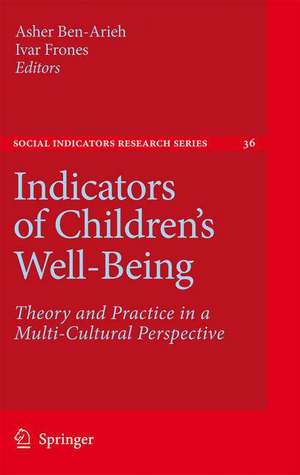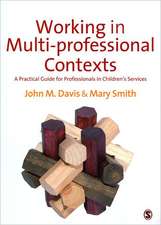Indicators of Children's Well-Being: Theory and Practice in a Multi-Cultural Perspective: Social Indicators Research Series, cartea 36
Editat de Asher Ben-Arieh, Ivar Frønesen Limba Engleză Hardback – 18 dec 2008
| Toate formatele și edițiile | Preț | Express |
|---|---|---|
| Paperback (1) | 1426.53 lei 6-8 săpt. | |
| SPRINGER NETHERLANDS – 28 oct 2010 | 1426.53 lei 6-8 săpt. | |
| Hardback (1) | 1433.83 lei 6-8 săpt. | |
| SPRINGER NETHERLANDS – 18 dec 2008 | 1433.83 lei 6-8 săpt. |
Din seria Social Indicators Research Series
- 15%
 Preț: 601.13 lei
Preț: 601.13 lei - 5%
 Preț: 861.64 lei
Preț: 861.64 lei - 18%
 Preț: 945.47 lei
Preț: 945.47 lei - 15%
 Preț: 644.30 lei
Preț: 644.30 lei - 18%
 Preț: 959.50 lei
Preț: 959.50 lei - 15%
 Preț: 645.60 lei
Preț: 645.60 lei - 18%
 Preț: 1234.94 lei
Preț: 1234.94 lei - 15%
 Preț: 640.06 lei
Preț: 640.06 lei - 15%
 Preț: 635.47 lei
Preț: 635.47 lei - 5%
 Preț: 1105.21 lei
Preț: 1105.21 lei - 15%
 Preț: 646.11 lei
Preț: 646.11 lei - 18%
 Preț: 1233.06 lei
Preț: 1233.06 lei - 18%
 Preț: 953.03 lei
Preț: 953.03 lei - 5%
 Preț: 1101.37 lei
Preț: 1101.37 lei - 15%
 Preț: 644.82 lei
Preț: 644.82 lei - 18%
 Preț: 948.92 lei
Preț: 948.92 lei - 15%
 Preț: 642.51 lei
Preț: 642.51 lei - 18%
 Preț: 954.45 lei
Preț: 954.45 lei - 18%
 Preț: 1235.76 lei
Preț: 1235.76 lei -
 Preț: 407.56 lei
Preț: 407.56 lei - 15%
 Preț: 642.83 lei
Preț: 642.83 lei - 18%
 Preț: 955.70 lei
Preț: 955.70 lei - 15%
 Preț: 644.49 lei
Preț: 644.49 lei - 18%
 Preț: 952.89 lei
Preț: 952.89 lei - 15%
 Preț: 648.89 lei
Preț: 648.89 lei - 15%
 Preț: 645.47 lei
Preț: 645.47 lei - 18%
 Preț: 1224.54 lei
Preț: 1224.54 lei
Preț: 1433.83 lei
Preț vechi: 1509.29 lei
-5% Nou
Puncte Express: 2151
Preț estimativ în valută:
274.45€ • 298.21$ • 230.69£
274.45€ • 298.21$ • 230.69£
Carte tipărită la comandă
Livrare economică 21 aprilie-05 mai
Preluare comenzi: 021 569.72.76
Specificații
ISBN-13: 9781402093036
ISBN-10: 1402093039
Pagini: 590
Ilustrații: XII, 590 p.
Dimensiuni: 155 x 235 x 33 mm
Greutate: 1.02 kg
Ediția:2009
Editura: SPRINGER NETHERLANDS
Colecția Springer
Seria Social Indicators Research Series
Locul publicării:Dordrecht, Netherlands
ISBN-10: 1402093039
Pagini: 590
Ilustrații: XII, 590 p.
Dimensiuni: 155 x 235 x 33 mm
Greutate: 1.02 kg
Ediția:2009
Editura: SPRINGER NETHERLANDS
Colecția Springer
Seria Social Indicators Research Series
Locul publicării:Dordrecht, Netherlands
Public țintă
ResearchCuprins
Social Indicators of Children Well Being: Past, Present, and Future.- Social Indicators of Children Well Being: Past, Present, and Future.- Conceptualizing Indicators of Children Well-Being.- Theorizing Indicators.- Children’S Conceptualisation(S) Of Their Well-Being.- Achieving Consensus In Developing A National Set Of Child Well-Being Indicators.- Young People’S Perception Of Being Safe – Globally & Locally.- Self-Reported Fears As Indicators Of Young Childrens Well-Being In Societal Change: A Cross-Cultural Perspective.- Studying children in armed conflict: data production, social indicators and analysis.- The Values Adolescents Aspire to, Their Well-being and the Values Parents Aspire to for Their Children.- Types of Indicators.- Longitudinal Indicators of the Social Context of Families: Beyond the Snapshot.- The Well-Being Of 12 - To 16-Year-Old Adolescents And Their Parents: Results From 1999 To 2003 Spanish Samples1,2.- Self-Reports Of Child Maltreatment In The U.S.: A Key Social Indicator.- The Potential Role Of Conflict Resolution Schemas In Adolescent Psychosocial Adjustment.- Monitoring Indicators of Children’s Victimization in School: Linking National-, Regional-, and Site-Level Indicators.- Indices of Children Well Being.- Indicators and Indices of Child Well-Being: A Brief American History.- Measuring Trends in Child Well-Being: An Evidence-Based Approach.- An Index of Child Well-Being in the European Union.- An Index of the Condition of Children: The Ideal and a Less-than-Ideal U.S. Example.- Using Indicators for Local, National and Comparative Studies.- Health Outcomes for Children in Canfrrada, England, Norway and The United States.- Child and Family Outcomes in New York and Tel Aviv: Using Social Indicators in a City Level ComparativeAnalysis.- Reporting on Children’S Well-Being: The State of London’S Children Reports.- Using Child and Family Indicators to Influence Communities and Policy in Los Angeles County.- Native American Kids: American Indian Children’s Well-Being Indicators for the Nation and Two States.- Neighborhood Characteristics, Parenting, and Children’s Safety.- Indicators of Child Well-Being Through a Neighborhood Lens.
Textul de pe ultima copertă
The original articles presented in this book represent both a set of analyses of families, peers, schooling, communities and the broader social and economic environment of childhood, and an illustration of how the use of indicators enhances understanding of children’s risks and well-being. Covering a broad range of topics, from the theorizing of children’s well-being to the development of measures at local and national level, the book also outlines pivotal methodological and conceptual issues. A distinguished, international group of researchers provide insights into the dynamics of children’s well-being, using indicators as a means to confront new phenomena as well as to bridge data and theory.
Both because of its perspectives on childhood and children’s well-being and the range of topics covered, this book will be of value to researchers and students of the social sciences, as well as to policymakers and professionals in related fields.
Reprinted from Social Indicators Research, 80.1, 83.1 and 84.3 and Child Indicators Research, 1.1 (2008).
Both because of its perspectives on childhood and children’s well-being and the range of topics covered, this book will be of value to researchers and students of the social sciences, as well as to policymakers and professionals in related fields.
Reprinted from Social Indicators Research, 80.1, 83.1 and 84.3 and Child Indicators Research, 1.1 (2008).
Caracteristici
Represents a set of analysis of families, peers, schooling, communities and the broader social and economic environment of childhood Illustrates how the use of indicators provide understanding of children’s risk and well-being Outlines pivotal methodological and conceptual issues of children’s well-being













